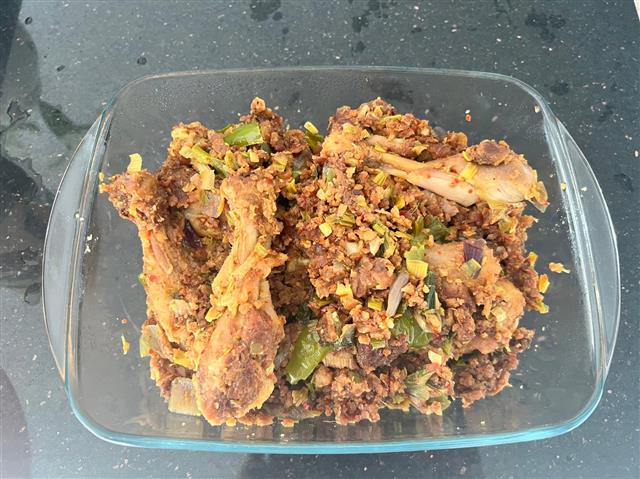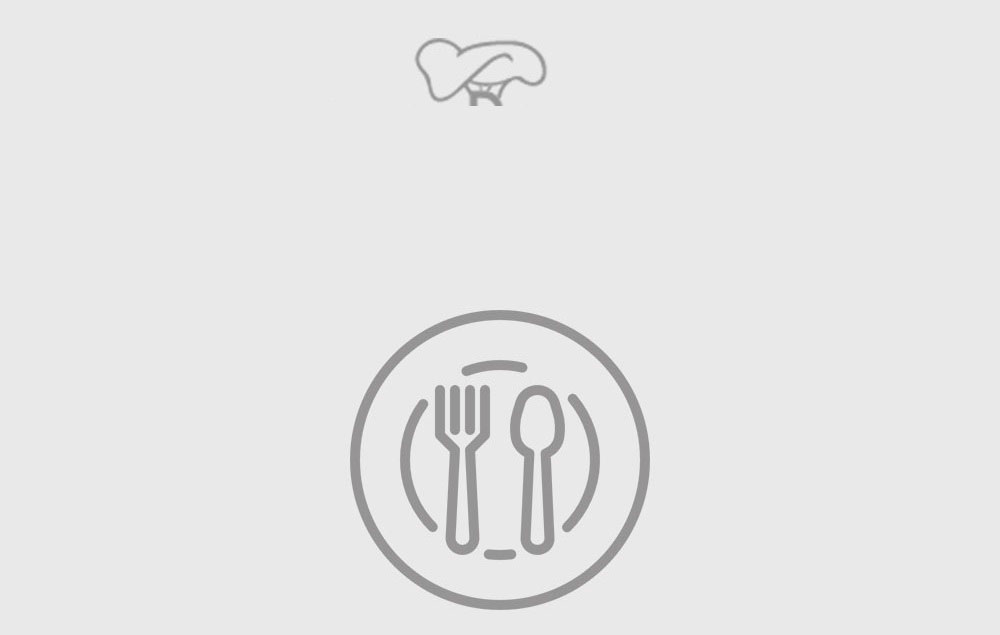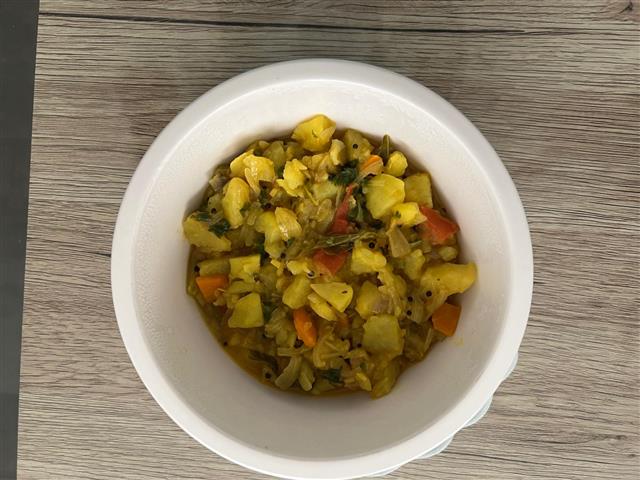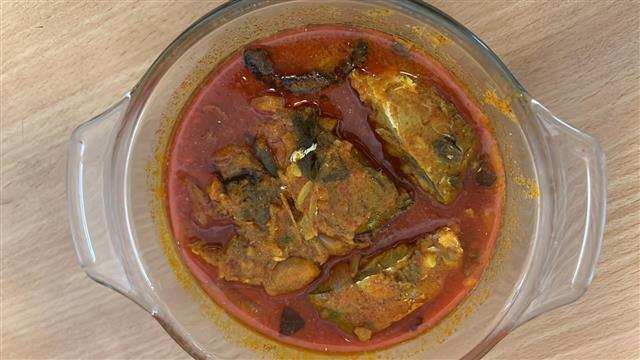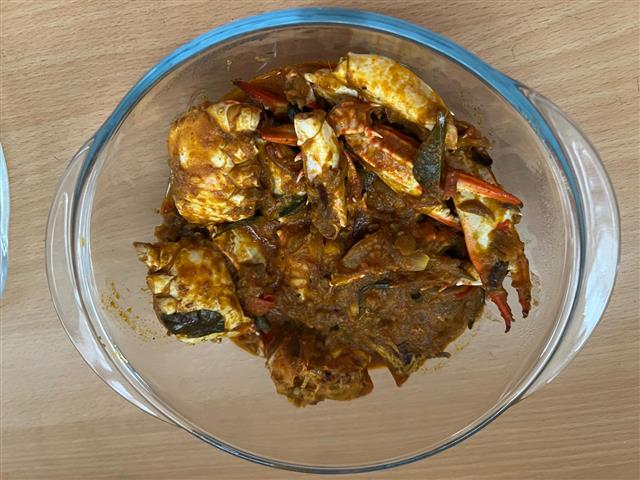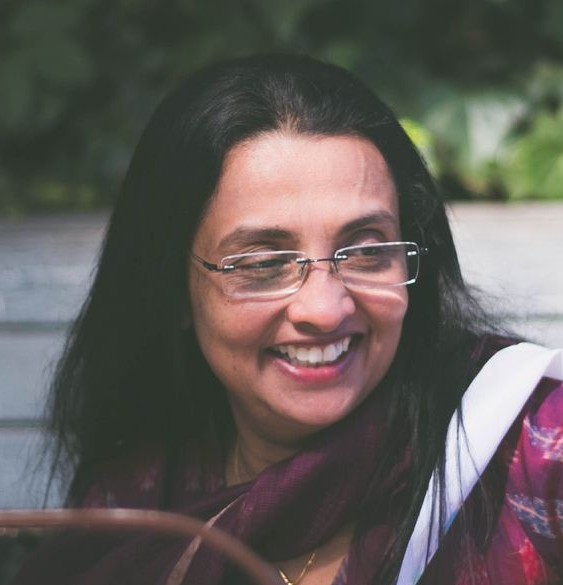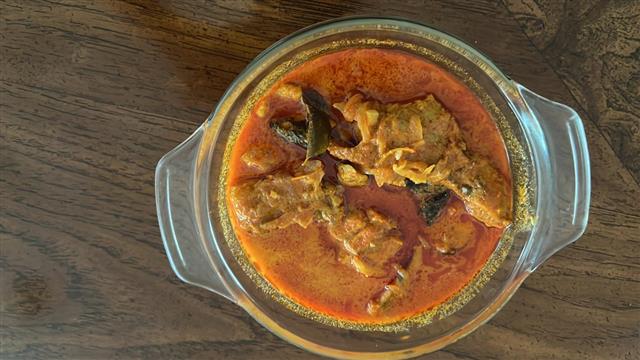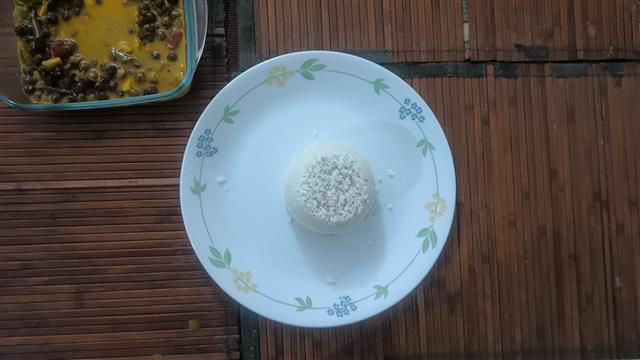
Beetroot Pachadi
(4 reviews)
Beetroot Pachadi is a vibrant, slightly sweet, and tangy Kerala-style side dish made with finely chopped beetroot, curd, and a gentle coconut oil tempering.
A star on the Sadhya during Onam and Vishu, this dish stands out for its jewel-like colour and refreshing taste. Traditionally served cold or at room temperature.
With its creamy and earthy taste, Beetroot Pachadi provides a cooling balance to spicier dishes.
Ingredients
Directions
- Finely chop the beetroot, onion, green chilli, and ginger.
- Heat coconut oil in a pan, add mustard seeds, and let them splutter.
- Add the chopped onion, green chilli, and ginger to the pan and sauté until fragrant.
- Add the chopped beetroot and curry leaves, and continue to fry until the beetroot softens.
- Turn off the heat, then add curd and salt to the mixture.
- Gently crush the mixture and loosen it to your desired consistency.
- Mix everything well and serve.
Cooking Tips
• Use minimal or no water: Beetroot has natural moisture and any excess water dilutes the dish
• Don't overcook the beetroot – You want it to be soft but not mushy. Overcooked beetroot can turn your pachadi into a watery mess..
• Cool before adding curd – Always cool the cooked beetroot before adding curd. This prevents it from curdling..
• Adjust the chilli – Beetroot already has a natural sweetness. Adjust the green chilli to balance the taste.
• Whisk the curd – Use slightly sour curd for traditional style and whisk it to prevent lumps.
• Fresh curry leaves – Adds that unmistakable Kerala aroma. Tear the leaves slightly before adding to release flavour.
How to Serve
• Serve chilled or at room temperature.
• As part of a Sadhya meal.
• With steamed rice and sambar for a comforting lunch.
• Complement mains like Kerala fish curry or spicy chicken roast.
• Pair with papadam and pickles for a saucy-crunchy snack food.
• As a colourful and healthy addition to lunchboxes.
• With adai or dosas, for a tangy-sweet contrast.
• Serve chilled during hot weather for a refreshing bite.
The Story Behind Beetroot Pachadi
Though pachadis have long held a place in Kerala's temple cuisine and home cooking, Beetroot Pachadi is a relatively modern entrant in the culinary scene.
The vegetable became easily available, and dishes featuring it started emerging in Kerala kitchens.
Earlier, Pachadi centred around cucumber, ash gourd, or okra. However, when home cooks began experimenting with colourful root vegetables, beetroot quickly became a favourite.
In many families, especially in central Kerala, Beetroot Pachadi became a Sadhya regular thanks to its festive appearance and kid-friendly sweetness. In my family, it was my great-aunt who borrowed it from a colleague's recipe book and brought it home. Soon, it took its place beside avial, kalan, and thoran every Onam.
What Is Beetroot Pachadi?
Beetroot Pachadi is a yogurt-based Kerala side dish, and part of the traditional Pachadi family, which includes various preparations of vegetable side dishes in curd, sometimes with coconut. This beetroot version uses minimal ingredients and often skips ground pastes in favour of sliced aromatics.
You gently sauté beetroot along with onions, ginger, and green chilli in coconut oil. Cool it and mix into fresh curd. The resulting dish is strikingly colourful with balanced flavours. Earthy zest from the beetroot, spiciness from the green chilli, and mild sweetness from the onion. The yogurt or Indian curd lends the tangy flavour, while everything is covered by the nuttiness of coconut oil.
This side is easy to prepare, but its visual and taste appeal make it a beloved inclusion in regular and festive spreads across Kerala.
Can any beetroot post end without talking about its health benefits?
Health Benefits of Beetroot
Beetroot isn't just a bright coloured vegetable, but it's packed with nutrients.
• Rich in antioxidants (betalains). These help fight inflammation and prevent oxidative stress in the body..
• Supports heart health. Dietary nitrates help regulate blood pressure and, in turn, keep your heart healthy.
• High in fibre and supports digestion and gut health.
• Loaded with essential nutrients like folate, iron, potassium, and vitamin C.
• Natural detoxifier that promotes liver health.
• Boosts stamina and endurance. This makes it ideal for maintaining an active lifestyle.
• Pairing it with probiotic-rich yogurt improves digestion while allowing you to benefit from its cooling properties..
All this makes Beetroot Pachadi both healing and satisfying, especially in hot and humid climates.
Pro Tips for Perfect Results
→ Always sauté, never boil: Pan-cooking concentrates beetroot flavor.
→ Use slightly sour curd: It enhances the balance of sweet, tangy, and spicy
Beetroot Pachadi Variations
With coconut-mustard paste: Some households add a lightly ground paste made of coconut and mustard seeds for a kichadi-style variation.
With grated beetroot: Instead of chopping, grating the beetroot creates a smoother texture and quicker cooking.
Add tempering with urad dal and red chillies: In Tamil Nadu style
North Kerala version: Uses more curd and is often slightly looser in consistency, acting like a beetroot raita.
Curry leaves and shallots: These can be used instead of regular onion for a more traditional flavour.
Sweetened version: Add a pinch of jaggery for a subtle sweet note—popular in some Palakkad Brahmin households.
With mustard-coconut paste: In some regions, the cooked beetroot is mixed with a ground paste of coconut, mustard seeds, and curd for a thicker, richer base.
Diet-Friendly Adaptations
Vegan: Use dairy-free yogurt like cashew or coconut curd for a fully vegan version.
Low-fat: Use low-fat curd or Greek yogurt without compromising flavour.
No onion version: For fasting days, omit onion and retain tang with ginger, green chilli, and curry leaves.
Storing & Reheating Tips
→ Fridge: Store in the fridge in an airtight container for up to 2 days.
→ Reheat: Do not reheat. This is a cold side dish; reheating will cause the curd to split.
→ Freeze: Do not freeze, as curd doesn't store well.
Tip: If the curd thickens in the fridge, thin it down it with a splash of water or milk before serving.
Common Mistakes to Avoid
→ Adding curd while beetroot is hot – This will curdle the yogurt and ruin the texture.
→ Overcooking beetroot – You want it soft, not mushy, and to retain a bit of bite.
→ Using runny curd – This makes the dish watery. Use thick curd or strain it slightly.
→ Skipping the tempering: – The flavour of coconut oil and mustard is key to making it truly Kerala-style.
→ Using sweetened or flavored yogurt – Always use plain, unsweetened curd.
→ Dilute the yogurt* – Add a tablespoon of water to reduce the thickness.
→ Not sautéing aromatics enough – Undercooked onion or ginger can leave a raw taste.
Frequently Asked Questions
Can I make this a day ahead? Yes! Beetroot Pachadi tastes even better after a few hours of resting. Just keep it refrigerated and bring it to room temperature before serving.
Is this the same as beetroot raita? Not exactly. While both are curd-based, raita is often made with raw vegetables without any cooking. It has like green chilli, chaat masala, or pepper and is garnished with coriander or mint leaves. For Pachadi, we cook the vegetables, coconut, and aromatics, and finish with a tempering.
Can I use boiled beetroot? Yes, but pan-cooking beetroot with spices brings out a better flavour. Boiled beetroot can be a quick shortcut, though.
Is this dish spicy? Not at all. It's mild, with a little kick from green chilli. Adjust according to your preference.
What does the dish taste like? It's tangy, slightly sweet, and creamy, with a warm note from the ginger and a classic Kerala touch from curry leaves and coconut oil.
Equipment Needed
→ Heavy-bottomed pan or skillet
→ Small kadai or pan for tempering
→ Spatula
→ Sharp knife for fine chopping
→ Mixing bowl for curd
→ Grater (if choosing to grate beetroot)
→ Serving bowl
